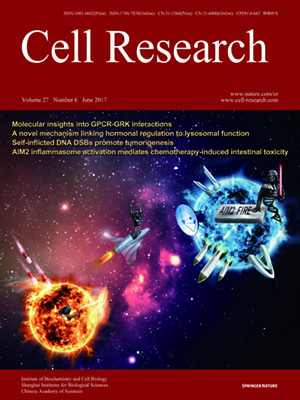
Volume 27, No 6, Jun 2017
ISSN: 1001-0602
EISSN: 1748-7838 2018
impact factor 17.848*
(Clarivate Analytics, 2019)
Volume 27 Issue 6, June 2017: 764-783 | Open Access
ORIGINAL ARTICLES
Self-inflicted DNA double-strand breaks sustain tumorigenicity and stemness of cancer cells
Xinjian Liu1, Fang Li1, Qian Huang2, Zhengxiang Zhang2, Ling Zhou3, Yu Deng1, Min Zhou1,4, Donald E Fleenor5, He Wang6, Michael B Kastan5,7 and Chuan-Yuan Li1,5,7
1Department of Dermatology, Duke University Medical Center, Durham, NC 27710, USA
2Cancer Center, Shanghai General Hospital, School of Medicine, Shanghai Jiaotong University, Shanghai 201620, China
3Department of Surgery, Shanghai General Branch Hospital, School of Medicine, Shanghai Jiaotong University, Shanghai 200081, China
4State Key Laboratory of Oncogenes and Related Genes, Shanghai Cancer Institute, Shanghai JiaotongUniversity, Shanghai 200032, China
5Department of Pharmacology and Cancer Biology, Duke University Medical Center, Durham, NC 27710, USA
6West China Second University Hospital, Sichuan University, Chengdu 610041, China
7Duke Cancer Institute, Duke University Medical Center, Durham, NC 27710, USA
Correspondence: Chuan-Yuan Li, Tel: +1 919 6138754(chuan.li@duke.edu)
DNA double-strand breaks (DSBs) are traditionally associated with cancer through their abilities to cause chromosomal instabilities or gene mutations. Here we report a new class of self-inflicted DNA DSBs that can drive tumor growth irrespective of their effects on genomic stability. We discover a mechanism through which cancer cells cause DSBs in their own genome spontaneously independent of reactive oxygen species or replication stress. In this mechanism, low-level cytochrome c leakage from the mitochondria leads to sublethal activation of apoptotic caspases and nucleases, which causes DNA DSBs. In response to these spontaneous DNA DSBs, ATM, a key factor involved in DNA damage response, is constitutively activated. Activated ATM leads to activation of transcription factors NF-κB and STAT3, known drivers of tumor growth. Moreover, self-inflicted DNA DSB formation and ATM activation are important in sustaining the stemness of patient-derived glioma cells. In human tumor tissues, elevated levels of activated ATM correlate with poor patient survival. Self-inflicted DNA DSBs therefore are functionally important for maintaining the malignancy of cancer cells.
10.1038/cr.2017.41
FULL TEXT | PDF
Browse 1853


